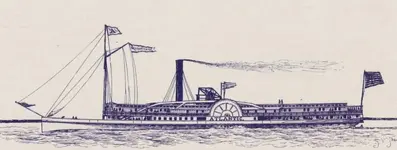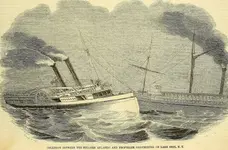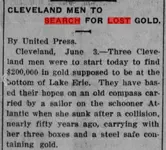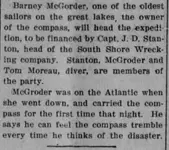

Atlantic rests under 150 feet (46 m) of water near Long Point.That fall, diver John Green was hired by American Express to dive the wreck and retrieve
Atlantic's safe and money known to be in a cabin, but his attempts failed. In 1855, Green returned with the schooner
Yorktown, located the safe, and moved it out to the deck of
Atlantic.But Green contracted a near-fatal case of the bends and was taken to a hospital; he was in recovery until the summer of 1856. When he returned to the wreck on 1 July 1856, he found the safe and money were gone. Another diver, Eliot Harrington, had found them both and hauled them to the surface. $36,700 was taken from
Atlantic's safe, at a time when a decent wage was a dollar a day. American Express went to court for the money; the ending settlement gave Harrington and the four others who worked with him a bit under $2,000 each, with American Express taking the rest.
The legal battle over the cause of the wreck went to the United States Supreme Court, who ruled that both ships were at fault. In 1867, the Western Wrecking Company was formed to try and raise
Atlantic, but this plan was abandoned two years later.
The wreck was rediscovered in 1984 by Port Dover, Ontario diver Michael Lynn Fletcher; the aquatic plants formerly covering the wreck were largely eaten away by zebra mussels. In 1991, a California-based diving company, Mar-Dive, announced that they had found
Atlantic, and paid the state of Ohio $14,000 to reform the Western Wrecking Company.But since
Atlantic rests inside Canadian waters, the government of Ontario moved to prevent the removal of artifacts from
Atlantic, taking the issue to Ontario divisional court.The judge ruled that
Atlantic belonged to Ontario. To protect the wreck, an electronic monitoring system was installed that will alert the Ontario Provincial Police if a vessel stays for too long above the wreck.









